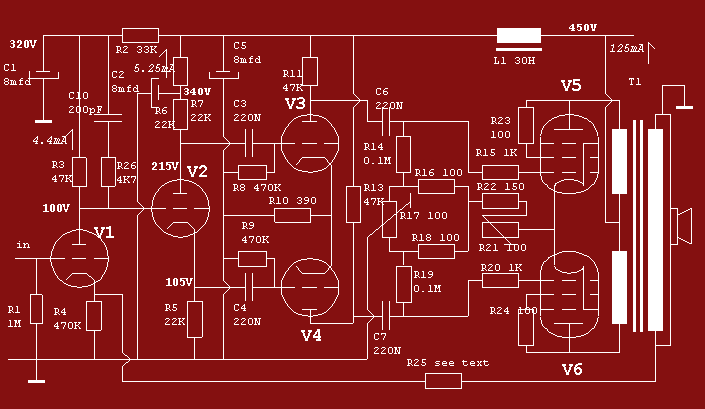The Circuit
|
|||||
 |
|||||
|
The picture at the top of this page shows the overall circuit of the revised version as published in 1949 in "Wireless World" and indeed it is simple! It consists of three stages, Note that the values of C3 and C4 are the values from the "Ultra Linear Williamson" that was published much later. The input stage combined with the "concertina" phasesplitter using tubes as 6SN7, 12AU7 or ECC82. The driver stage. In the original version a 6SN7 was used. For those who are interested in the experiment: 12BH7 and 12AU7 or ECC82 . The power stage using in the original version a pair of KT66 that was impossible to obtain. Rumors are that it is in the Far East in production again. Alternatively try the latest version of "Sovtek's" 6L6WXG or 5881 that are capable of handling the dissipation. The slim 6L6GC versions that are in fact 6L6GB wont handle the current! The EL34 or its US counterpart 6CA7 can also be used. American constructors tend to prefer the foreign EL34 and the Europeans vice versa. Currently the Tesla KT77 is available and tried by the author with great succes, leaving the 6L6 versions way behind. More important then looking at the three individual stages that are quite simple is the fact that those stages together make the amplifier that became famous! Designers took ample efforts to compose an amplifier out of succeeding stages so that the distortion in one stage reduced distortion in the next stage. That is why some circuits became classics! Every change in the circuit can turn a masterpiece into a disaster if you don't know what you are doing. On paper is exchanging the 6SN7 for the more modern 12AU7 modest surgery. In reality you increase the bandwidth of the phasesplitter because the capacitve load of the 12AU7 on the phasesplitter is only half. This alone can cause instability! The main reason the Williamson amplifier became famous was the output transformer. This was a piece of workmanship that was not seen before. Williamson had calculated that its bandwidth should range straight from 2Hz to 60.000Hz (being the third harmonic of 20.000Hz.)! Only the best transformer possible would allow the amp to operate stable with a strong negative feedback loop. Nowadays it is a very common to design amplifiers so that they are straight to 20kHz without feedback. detail" sound of many amps that makes listening tiring. |
|||||
|
|||||